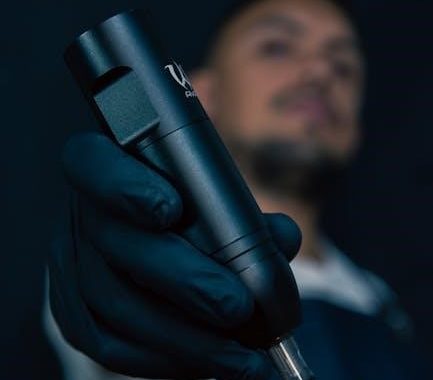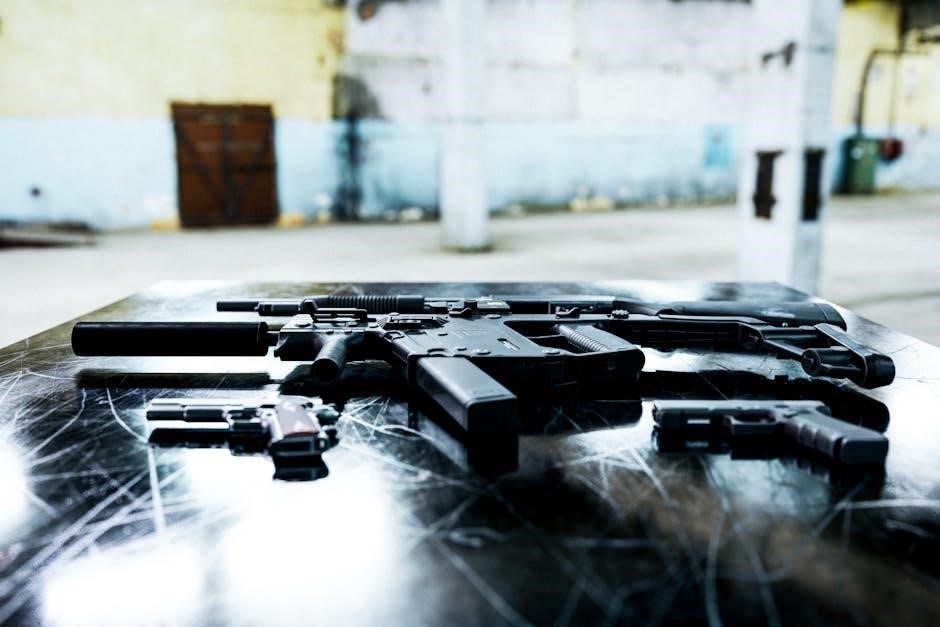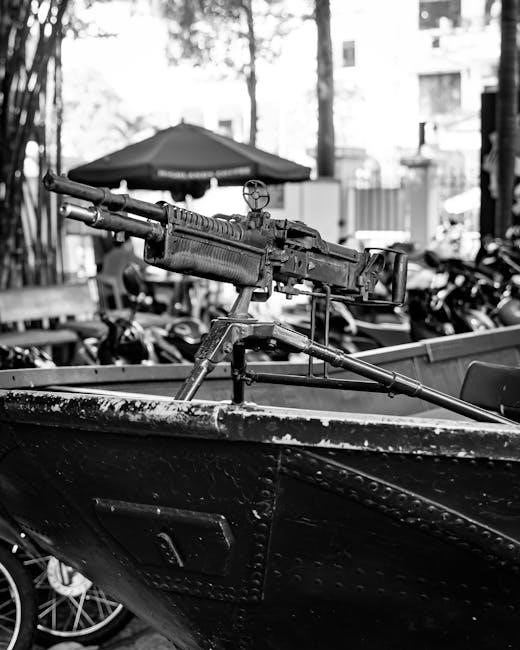mg34 and mg42 machine guns pdf

mg34 and mg42 machine guns pdf
The MG34 and MG42 were revolutionary German machine guns introduced in 1934 and 1942, respectively, known for their versatility, high rates of fire, and combat effectiveness during WWII.
1;1 Historical Context and Development
The MG34, introduced in 1934, was the first general-purpose machine gun, designed by Heinrich Vollmer for the German Wehrmacht. It replaced older heavy machine guns, offering portability and versatility. The MG42, developed in 1942, was created to address the MG34’s high production costs and complexity. Designed by a team at Mauser, it used stamped steel for efficiency and affordability. Both weapons were pivotal in WWII, with the MG34 seeing early action in the Spanish Civil War and the MG42 becoming iconic for its reliability and firepower. Their development reflected Germany’s focus on modern, adaptable weaponry, setting a new standard for machine guns globally.
1.2 Importance in World War II
The MG34 and MG42 played pivotal roles in World War II, becoming symbols of German firepower. The MG34, introduced early in the war, excelled in various roles, from light infantry support to mounted use on vehicles. Its reliability and adaptability made it a favorite among troops. The MG42, with its higher rate of fire and simplified production, dominated later years, earning the nickname “Hitler’s Buzzsaw” for its distinctive sound. Both weapons significantly influenced battlefield tactics, forcing Allied forces to adapt their strategies. Their impact was so profound that the MG42 remained in use decades after the war, cementing their legacy as two of the most influential machine guns in military history.

Design and Functionality of the MG34
The MG34, introduced in 1934, was a revolutionary air-cooled, recoil-operated general-purpose machine gun, known for its versatility, supporting both light and medium roles with a quick-change barrel system.
2.1 Key Features and Mechanisms
The MG34 was a groundbreaking general-purpose machine gun, combining portability and firepower. It featured an air-cooled, recoil-operated design, allowing for sustained fire without overheating. The gun used a 7.92x57mm Mauser cartridge, fed from a 50-round belt, and could achieve a rate of fire of 800-900 rounds per minute. Its modular design enabled quick conversion between light and medium roles, while the quick-change barrel system enhanced combat readiness. The MG34’s robust construction, using machined steel, ensured reliability, though its weight limited mobility. These features made it a versatile and dominant weapon on the battlefield, setting a new standard for machine gun design and functionality during World War II.
2.2 Quick-Change Barrel System
The MG34’s quick-change barrel system was a significant innovation, allowing gunners to replace a overheated barrel in seconds. The process involved disengaging the barrel lock, rotating it, and removing it, then inserting a cooled replacement. This feature ensured continuous firepower without prolonged downtime, making the MG34 highly effective in sustained combat scenarios. The system’s simplicity and efficiency set a precedent for future machine gun designs, enhancing battlefield versatility and soldier capability, and became a hallmark of German engineering during WWII.

Design and Functionality of the MG42
The MG42, introduced in 1942, featured a recoil-operated, air-cooled design with a high rate of fire, making it a reliable and adaptable general-purpose machine gun.
3.1 Innovations and Improvements Over the MG34
The MG42 introduced several key innovations over the MG34, including a simplified manufacturing process using stamped metal parts, reducing production time and costs. It also featured a faster rate of fire, with the ability to discharge up to 1,200 rounds per minute, enhancing its suppressive capabilities. The MG42 incorporated a more reliable recoil mechanism, improving its performance in harsh combat conditions. Additionally, its barrel change system was streamlined, allowing quicker swaps during intense engagements. These improvements made the MG42 a more practical and effective weapon for mass production and deployment on the battlefield, solidifying its role as a dominant force in World War II.
3.2 Rate of Fire and Recoil Mechanism
The MG42 boasted an impressive rate of fire, capable of delivering between 900 to 1,200 rounds per minute, making it one of the fastest-firing machine guns of its era. Its recoil mechanism utilized a roller-locked short recoil system, which not only reduced recoil but also allowed for smoother operation during prolonged firing sessions. This design enhancement significantly improved accuracy and control, even at high rates of fire. The MG42’s exceptional rate of fire earned it the nickname “Hitler’s Buzzsaw” due to the distinct sound of its rapid discharges. This capability made it a formidable weapon on the battlefield, allowing German forces to lay down overwhelming suppressive fire, which often dictated the pace of combat engagements.
Differences Between the MG34 and MG42
The MG34 and MG42 differed in manufacturing, materials, and combat performance. The MG34 was precision-made, while the MG42 used stamped parts for faster production, enhancing wartime availability and reliability.
4.1 Manufacturing and Material Differences
The MG34 and MG42 exhibited notable differences in their manufacturing processes and material usage, primarily driven by the demands of wartime production. The MG34, introduced earlier, was crafted with precision, utilizing milled steel parts. This method, while yielding a more durable and reliable weapon, was time-consuming and resource-intensive, making it less suitable for rapid mass production. In contrast, the MG42, developed later, adopted stamped steel parts, which significantly accelerated production and reduced costs. This shift allowed for a higher production rate, crucial for meeting the escalating needs of World War II. Additionally, the MG42 incorporated more plastic components, further reducing production time and weight. These changes in materials and manufacturing techniques were essential for maintaining weapon supply amidst the war’s pressures, though they may have compromised certain aspects of durability and complexity.
4.2 Reliability and Combat Performance
The MG34 and MG42 demonstrated distinct reliability and combat performance characteristics. The MG34, with its meticulously machined components, was highly accurate and reliable under ideal conditions, making it a favorite among troops for its precision and versatility. However, its reliability waned in harsh environments, such as muddy or sandy conditions, where its intricate design was more prone to jamming. In contrast, the MG42, with its simpler stamped construction, proved more robust and reliable in extreme battlefield conditions. Its higher rate of fire and reduced recoil mechanism made it devastating in suppressive fire roles. While the MG34 excelled in precision, the MG42’s durability and ease of use under stress cemented its reputation as a superior combat weapon, particularly in the later stages of World War II.

Combat Use and Tactical Impact
The MG34 and MG42 were pivotal in WWII, with the MG34 dominating early battles and the MG42 excelling later, thanks to its enhanced rate of fire and reliability, revolutionizing suppressive fire tactics and solidifying their legendary status as battlefield weapons.
5.1 Role of the MG34 in Early WWII Battles
The MG34 played a pivotal role in early WWII battles, showcasing its versatility and reliability. Introduced in 1934, it quickly became a cornerstone of German infantry tactics, excelling as both a light and medium machine gun. Its high rate of fire and accuracy made it a formidable weapon, capable of delivering suppressive fire over long ranges. During the invasion of Poland and France, the MG34 proved indispensable, allowing German forces to maintain superior firepower. Its portability and adaptability enabled its use in various combat scenarios, from infantry assaults to anti-aircraft roles. Soldiers praised its durability and ease of operation, which minimized downtime in the field. The MG34’s performance in these early campaigns set the standard for future machine gun design and cemented its reputation as a battle-proven weapon.
5.2 Dominance of the MG42 in Later War Years
The MG42 became the cornerstone of German firepower in the later years of WWII, outshining its predecessor, the MG34. Introduced in 1942, it boasted a higher rate of fire, reaching up to 1,200 rounds per minute, and its simpler, more robust design made it easier to manufacture and maintain. Its reliability in harsh conditions and ease of operation solidified its status as the primary machine gun for German forces. The MG42’s distinctive sound earned it the nickname “Hitler’s Buzzsaw,” striking fear into Allied troops. Its versatility allowed it to excel in both offensive and defensive roles, making it a key factor in German tactics. Despite the war’s outcome, the MG42’s influence on machine gun design endured, leaving a lasting legacy in military history.

Legacy and Influence on Modern Machine Guns
The MG34 and MG42 set the standard for modern machine guns, inspiring designs like the Rheinmetall MG3, which continues their legacy of versatility and reliability.
6.1 Post-War Adoption and Modifications
Following World War II, the MG34 and MG42’s influence extended globally, with various nations adopting and modifying the designs. The MG42, in particular, inspired the post-war German MG3, which remains in service today. The MG3 retains the MG42’s core mechanics but incorporates improvements such as a chromium-lined barrel for enhanced durability. Many countries, including Italy, Spain, and Pakistan, have produced their own variants, often chambering the weapon for different cartridges like the 7.62x51mm NATO. These adaptations highlight the timeless versatility of the original German designs. The MG42’s reputation for reliability and firepower ensured its continued relevance, cementing its legacy as one of the most influential machine guns in modern military history.
6.2 Cultural and Historical Significance
The MG34 and MG42 hold a prominent place in military history and popular culture, symbolizing German engineering and firepower. Nicknamed “Hitler’s Buzzsaw” due to their distinctive sound, these weapons became synonymous with the intensity of WWII combat. Their influence extended beyond the battlefield, inspiring numerous post-war machine gun designs globally. The MG42, in particular, is celebrated for its reliability and high rate of fire, making it a favorite among collectors and historians. In films and media, the MG42 is often depicted as the quintessential machine gun, further cementing its cultural impact. Both weapons represent the pinnacle of German military innovation during WWII, leaving a lasting legacy in the development of modern firearms and their perception in historical narratives.